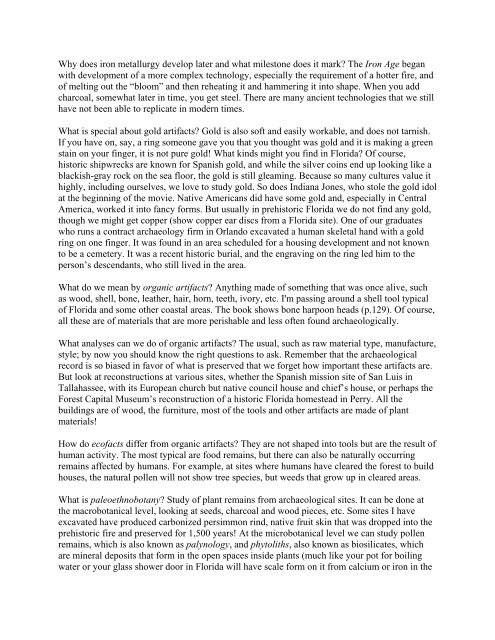INTRODUCTION TO ARCHAEOLOGY Nancy White - Touro Institute
INTRODUCTION TO ARCHAEOLOGY Nancy White - Touro Institute
INTRODUCTION TO ARCHAEOLOGY Nancy White - Touro Institute
Create successful ePaper yourself
Turn your PDF publications into a flip-book with our unique Google optimized e-Paper software.
Why does iron metallurgy develop later and what milestone does it mark? The Iron Age began<br />
with development of a more complex technology, especially the requirement of a hotter fire, and<br />
of melting out the “bloom” and then reheating it and hammering it into shape. When you add<br />
charcoal, somewhat later in time, you get steel. There are many ancient technologies that we still<br />
have not been able to replicate in modern times.<br />
What is special about gold artifacts? Gold is also soft and easily workable, and does not tarnish.<br />
If you have on, say, a ring someone gave you that you thought was gold and it is making a green<br />
stain on your finger, it is not pure gold! What kinds might you find in Florida? Of course,<br />
historic shipwrecks are known for Spanish gold, and while the silver coins end up looking like a<br />
blackish-gray rock on the sea floor, the gold is still gleaming. Because so many cultures value it<br />
highly, including ourselves, we love to study gold. So does Indiana Jones, who stole the gold idol<br />
at the beginning of the movie. Native Americans did have some gold and, especially in Central<br />
America, worked it into fancy forms. But usually in prehistoric Florida we do not find any gold,<br />
though we might get copper (show copper ear discs from a Florida site). One of our graduates<br />
who runs a contract archaeology firm in Orlando excavated a human skeletal hand with a gold<br />
ring on one finger. It was found in an area scheduled for a housing development and not known<br />
to be a cemetery. It was a recent historic burial, and the engraving on the ring led him to the<br />
person’s descendants, who still lived in the area.<br />
What do we mean by organic artifacts? Anything made of something that was once alive, such<br />
as wood, shell, bone, leather, hair, horn, teeth, ivory, etc. I'm passing around a shell tool typical<br />
of Florida and some other coastal areas. The book shows bone harpoon heads (p.129). Of course,<br />
all these are of materials that are more perishable and less often found archaeologically.<br />
What analyses can we do of organic artifacts? The usual, such as raw material type, manufacture,<br />
style; by now you should know the right questions to ask. Remember that the archaeological<br />
record is so biased in favor of what is preserved that we forget how important these artifacts are.<br />
But look at reconstructions at various sites, whether the Spanish mission site of San Luis in<br />
Tallahassee, with its European church but native council house and chief’s house, or perhaps the<br />
Forest Capital Museum’s reconstruction of a historic Florida homestead in Perry. All the<br />
buildings are of wood, the furniture, most of the tools and other artifacts are made of plant<br />
materials!<br />
How do ecofacts differ from organic artifacts? They are not shaped into tools but are the result of<br />
human activity. The most typical are food remains, but there can also be naturally occurring<br />
remains affected by humans. For example, at sites where humans have cleared the forest to build<br />
houses, the natural pollen will not show tree species, but weeds that grow up in cleared areas.<br />
What is paleoethnobotany? Study of plant remains from archaeological sites. It can be done at<br />
the macrobotanical level, looking at seeds, charcoal and wood pieces, etc. Some sites I have<br />
excavated have produced carbonized persimmon rind, native fruit skin that was dropped into the<br />
prehistoric fire and preserved for 1,500 years! At the microbotanical level we can study pollen<br />
remains, which is also known as palynology, and phytoliths, also known as biosilicates, which<br />
are mineral deposits that form in the open spaces inside plants (much like your pot for boiling<br />
water or your glass shower door in Florida will have scale form on it from calcium or iron in the
















